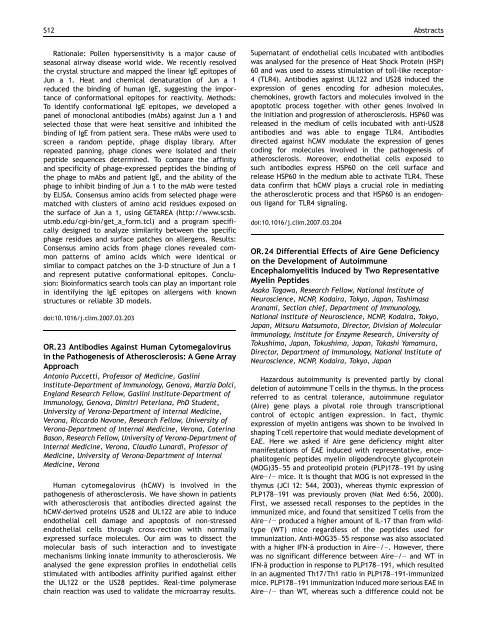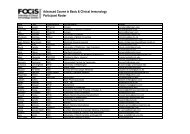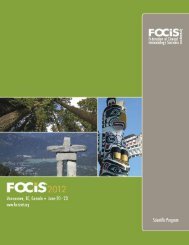Oral Presentations - Federation of Clinical Immunology Societies
Oral Presentations - Federation of Clinical Immunology Societies
Oral Presentations - Federation of Clinical Immunology Societies
Create successful ePaper yourself
Turn your PDF publications into a flip-book with our unique Google optimized e-Paper software.
S12 Abstracts<br />
Rationale: Pollen hypersensitivity is a major cause <strong>of</strong><br />
seasonal airway disease world wide. We recently resolved<br />
the crystal structure and mapped the linear IgE epitopes <strong>of</strong><br />
Jun a 1. Heat and chemical denaturation <strong>of</strong> Jun a 1<br />
reduced the binding <strong>of</strong> human IgE, suggesting the importance<br />
<strong>of</strong> conformational epitopes for reactivity. Methods:<br />
To identify conformational IgE epitopes, we developed a<br />
panel <strong>of</strong> monoclonal antibodies (mAbs) against Jun a 1 and<br />
selected those that were heat sensitive and inhibited the<br />
binding <strong>of</strong> IgE from patient sera. These mAbs were used to<br />
screen a random peptide, phage display library. After<br />
repeated panning, phage clones were isolated and their<br />
peptide sequences determined. To compare the affinity<br />
and specificity <strong>of</strong> phage-expressed peptides the binding <strong>of</strong><br />
the phage to mAbs and patient IgE, and the ability <strong>of</strong> the<br />
phage to inhibit binding <strong>of</strong> Jun a 1 to the mAb were tested<br />
by ELISA. Consensus amino acids from selected phage were<br />
matched with clusters <strong>of</strong> amino acid residues exposed on<br />
the surface <strong>of</strong> Jun a 1, using GETAREA (http://www.scsb.<br />
utmb.edu/cgi-bin/get_a_form.tcl) and a program specifically<br />
designed to analyze similarity between the specific<br />
phage residues and surface patches on allergens. Results:<br />
Consensus amino acids from phage clones revealed common<br />
patterns <strong>of</strong> amino acids which were identical or<br />
similar to compact patches on the 3-D structure <strong>of</strong> Jun a 1<br />
and represent putative conformational epitopes. Conclusion:<br />
Bioinformatics search tools can play an important role<br />
in identifying the IgE epitopes on allergens with known<br />
structures or reliable 3D models.<br />
doi:10.1016/j.clim.2007.03.203<br />
OR.23 Antibodies Against Human Cytomegalovirus<br />
in the Pathogenesis <strong>of</strong> Atherosclerosis: A Gene Array<br />
Approach<br />
Antonio Puccetti, Pr<strong>of</strong>essor <strong>of</strong> Medicine, Gaslini<br />
Institute-Department <strong>of</strong> <strong>Immunology</strong>, Genova, Marzia Dolci,<br />
England Research Fellow, Gaslini Institute-Department <strong>of</strong><br />
<strong>Immunology</strong>, Genova, Dimitri Peterlana, PhD Student,<br />
University <strong>of</strong> Verona-Department <strong>of</strong> Internal Medicine,<br />
Verona, Riccardo Navone, Research Fellow, University <strong>of</strong><br />
Verona-Department <strong>of</strong> Internal Medicine, Verona, Caterina<br />
Bason, Research Fellow, University <strong>of</strong> Verona-Department <strong>of</strong><br />
Internal Medicine, Verona, Claudio Lunardi, Pr<strong>of</strong>essor <strong>of</strong><br />
Medicine, University <strong>of</strong> Verona-Department <strong>of</strong> Internal<br />
Medicine, Verona<br />
Human cytomegalovirus (hCMV) is involved in the<br />
pathogenesis <strong>of</strong> atherosclerosis. We have shown in patients<br />
with atherosclerosis that antibodies directed against the<br />
hCMV-derived proteins US28 and UL122 are able to induce<br />
endothelial cell damage and apoptosis <strong>of</strong> non-stressed<br />
endothelial cells through cross-rection with normally<br />
expressed surface molecules. Our aim was to dissect the<br />
molecular basis <strong>of</strong> such interaction and to investigate<br />
mechanisms linking innate immunity to atherosclerosis. We<br />
analysed the gene expression pr<strong>of</strong>iles in endothelial cells<br />
stimulated with antibodies affinity purified against either<br />
the UL122 or the US28 peptides. Real-time polymerase<br />
chain reaction was used to validate the microarray results.<br />
Supernatant <strong>of</strong> endothelial cells incubated with antibodies<br />
was analysed for the presence <strong>of</strong> Heat Shock Protein (HSP)<br />
60 and was used to assess stimulation <strong>of</strong> toll-like receptor-<br />
4 (TLR4). Antibodies against UL122 and US28 induced the<br />
expression <strong>of</strong> genes encoding for adhesion molecules,<br />
chemokines, growth factors and molecules involved in the<br />
apoptotic process together with other genes involved in<br />
the initiation and progression <strong>of</strong> atherosclerosis. HSP60 was<br />
released in the medium <strong>of</strong> cells incubated with anti-US28<br />
antibodies and was able to engage TLR4. Antibodies<br />
directed against hCMV modulate the expression <strong>of</strong> genes<br />
coding for molecules involved in the pathogenesis <strong>of</strong><br />
atherosclerosis. Moreover, endothelial cells exposed to<br />
such antibodies express HSP60 on the cell surface and<br />
release HSP60 in the medium able to activate TLR4. These<br />
data confirm that hCMV plays a crucial role in mediating<br />
the atherosclerotic process and that HSP60 is an endogenous<br />
ligand for TLR4 signaling.<br />
doi:10.1016/j.clim.2007.03.204<br />
OR.24 Differential Effects <strong>of</strong> Aire Gene Deficiency<br />
on the Development <strong>of</strong> Autoimmune<br />
Encephalomyelitis Induced by Two Representative<br />
Myelin Peptides<br />
Asako Tagawa, Research Fellow, National Institute <strong>of</strong><br />
Neuroscience, NCNP, Kodaira, Tokyo, Japan, Toshimasa<br />
Aranami, Section chief, Department <strong>of</strong> <strong>Immunology</strong>,<br />
National Institute <strong>of</strong> Neuroscience, NCNP, Kodaira, Tokyo,<br />
Japan, Mitsuru Matsumoto, Director, Division <strong>of</strong> Molecular<br />
<strong>Immunology</strong>, Institute for Enzyme Research, University <strong>of</strong><br />
Tokushima, Japan, Tokushima, Japan, Takashi Yamamura,<br />
Director, Department <strong>of</strong> <strong>Immunology</strong>, National Institute <strong>of</strong><br />
Neuroscience, NCNP, Kodaira, Tokyo, Japan<br />
Hazardous autoimmunity is prevented partly by clonal<br />
deletion <strong>of</strong> autoimmune T cells in the thymus. In the process<br />
referred to as central tolerance, autoimmune regulator<br />
(Aire) gene plays a pivotal role through transcriptional<br />
control <strong>of</strong> ectopic antigen expression. In fact, thymic<br />
expression <strong>of</strong> myelin antigens was shown to be involved in<br />
shaping Tcell repertoire that would mediate development <strong>of</strong><br />
EAE. Here we asked if Aire gene deficiency might alter<br />
manifestations <strong>of</strong> EAE induced with representative, encephalitogenic<br />
peptides myelin oligodendrocyte glycoprotein<br />
(MOG)35–55 and proteolipid protein (PLP)178–191 by using<br />
Aire−/− mice. It is thought that MOG is not expressed in the<br />
thymus (JCI 12: 544, 2003), whereas thymic expression <strong>of</strong><br />
PLP178–191 was previously proven (Nat Med 6:56, 2000).<br />
First, we assessed recall responses to the peptides in the<br />
immunized mice, and found that sensitized T cells from the<br />
Aire−/− produced a higher amount <strong>of</strong> IL-17 than from wildtype<br />
(WT) mice regardless <strong>of</strong> the peptides used for<br />
immunization. Anti-MOG35–55 response was also associated<br />
with a higher IFN-ã production in Aire−/−. However, there<br />
was no significant difference between Aire−/− and WT in<br />
IFN-ã production in response to PLP178–191, which resulted<br />
in an augmented Th17/Th1 ratio in PLP178–191-immunized<br />
mice. PLP178–191 immunization induced more serious EAE in<br />
Aire−/− than WT, whereas such a difference could not be




